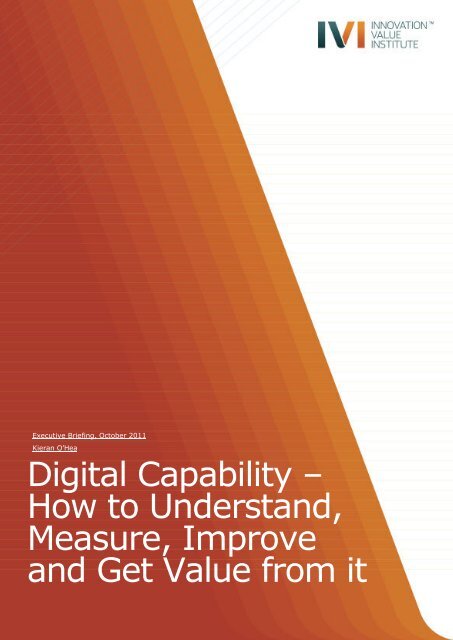Digital Capability - IVI Innovation Value Institute - National University ...
Digital Capability - IVI Innovation Value Institute - National University ...
Digital Capability - IVI Innovation Value Institute - National University ...
You also want an ePaper? Increase the reach of your titles
YUMPU automatically turns print PDFs into web optimized ePapers that Google loves.
Page 1<br />
Executive Briefing, October 2011<br />
Kieran O’Hea<br />
<strong>Digital</strong> <strong>Capability</strong> –<br />
How to Understand,<br />
Measure, Improve<br />
and Get <strong>Value</strong> from it
Abstract<br />
This executive briefing describes the need for organisations to<br />
improve their digital capability and proposes the development<br />
of a digital capability assessment process that will contribute to<br />
increased business value.<br />
Every organisation that has an Internet connection has an<br />
inherent digital capability. There is however a huge variation in<br />
the ways that organisations use this capability.<br />
Organisations that understand this opportunity and learn to<br />
measure and improve their own digital capability are likely to<br />
find themselves in a better position to compete in the digital<br />
economy.<br />
However, many organisations need help in order to gain a more<br />
comprehensive understanding at decision-making level of what<br />
digital capability is and how it can add value to their business.<br />
A dedicated process for measuring an organisation’s digital<br />
capability is therefore essential. However a reputable process<br />
that enables this to happen does not currently exist.<br />
As well as developing a process, there is also a need to<br />
convince organisations of the value of digital capability. Lack of<br />
awareness, unresponsive corporate culture and a generation<br />
gap at management level are among the reasons cited for the<br />
low adoption of digital technology in many organisations.<br />
A digital capability assessment process will help organisations of<br />
all types and sizes to get more value from the Internet. The<br />
immediate challenge is to complete the development of the<br />
process and begin delivering it to an engaged audience as soon<br />
as possible.<br />
KEYWORDS: <strong>Digital</strong> capability, digital transformation,<br />
organisations, SMEs, Internet, broadband, cloud, social media,<br />
mobile, smartphones, online, value, system, process, measure,<br />
assessment, competitiveness, customers, strategy, productivity,<br />
maturity, IT-CMF, enterprise-wide<br />
Page 2
Introduction<br />
With the majority of organisations now<br />
online, changes brought about by digital<br />
technologies are becoming inevitable across<br />
all business functions, not just in marketing.<br />
Business structures, systems, processes<br />
and, especially, human capabilities all need<br />
to evolve in order to reflect and exploit this<br />
opportunity.<br />
Organisations are having difficulty analysing<br />
the opportunities and challenges created by<br />
the Internet. Therefore, they are getting<br />
less value from their digital investments<br />
than they should be. Helping organisations<br />
to understand, measure, and improve their<br />
digital capability is fundamental to<br />
addressing this difficulty.<br />
All organisations, particularly those who are<br />
not digital natives but who now find<br />
themselves competing in a digital economy,<br />
need a new type of support to help them<br />
gain a competitive edge – a tool that helps<br />
them use digital technology to deliver value<br />
to their business.<br />
This tool or “decision-assistance<br />
programme” is primarily based on<br />
understanding, measuring and improving an<br />
organisation’s digital capability. The<br />
<strong>Innovation</strong> <strong>Value</strong> <strong>Institute</strong> (<strong>IVI</strong>) refers to its<br />
response to this need as the <strong>Digital</strong><br />
<strong>Capability</strong> Framework (DCF).<br />
For the purposes of this executive briefing,<br />
the term “digital” relates to a range of<br />
internally- and externally-facing business<br />
deliverables including, but not limited to,<br />
infrastructure (broadband, the Internet, the<br />
cloud), content (digital media, social media,<br />
mobile apps), channels (Intranets,<br />
websites, smartphones), services (digital<br />
marketing, digital advertising) and<br />
e-business applications (e-marketing,<br />
e-commerce, e-CRM and e-SCM).<br />
Understanding <strong>Digital</strong> <strong>Capability</strong><br />
Organisations tend to fall into one of the<br />
following four categories:<br />
1) No broadband connection.<br />
2) Poor quality broadband connection.<br />
3) Good quality broadband connection, but<br />
with underdeveloped or poorly<br />
performing digital strategy.<br />
4) Good quality broadband connection, with<br />
fully developed and highly effective<br />
digital strategy.<br />
<strong>Digital</strong> capability is a measure of a<br />
company’s potential to get business value<br />
from the Internet once connectivity issues<br />
have been resolved. Therefore, it primarily<br />
addresses the needs of organisations in<br />
category 3 above.<br />
<strong>Digital</strong> capability focuses on two<br />
complementary activities that will help<br />
organisations to “work smarter” and<br />
become more profitable; namely, reshaping<br />
customer value propositions and<br />
transforming operating models using digital<br />
technologies for greater customer<br />
interaction and collaboration [1].<br />
In a progressively digital environment,<br />
business functions will need to reflect a new<br />
focus on customer service, thereby<br />
requiring more open communication<br />
internally as well as externally. In turn, this<br />
will change relationships between<br />
employers and employees, as well as<br />
between employees and customers.<br />
Business structures, systems, processes<br />
and, especially, human capabilities will need<br />
to evolve in order to reflect and exploit<br />
these relationship changes. Such<br />
digitally-driven changes imply significant<br />
organisational redesign and will require<br />
equally significant planning processes.<br />
Achieving this will require a thorough<br />
understanding of the organisation’s digital<br />
capability.<br />
A new class of organisation is emerging –<br />
one that intensively uses collaborative web<br />
technologies to connect the internal efforts<br />
of employees and to extend the<br />
organisation’s reach to customers, partners,<br />
and suppliers. The implications of this<br />
development are far-reaching: in many<br />
industries, new competitive battle lines may<br />
form between organisations that use the<br />
web in sophisticated ways and organisations<br />
that feel uncomfortable with new,<br />
web-inspired management styles or that<br />
simply cannot execute their business at a<br />
sufficiently high level [2].<br />
An organisation with a strong IT capability<br />
does not necessarily have an equally strong<br />
digital capability. Concerns about the<br />
openness of the Internet and issues around<br />
ownership of the digital strategy often<br />
contribute to this disparity. For a variety of<br />
reasons – including lack of awareness,<br />
corporate culture, a generation gap at<br />
management level, or incorrect advice – the<br />
enterprise-wide deployment of digital<br />
technology and processes is often less<br />
extensive and less effective than it could<br />
be.<br />
Consequently, at decision-making level it is<br />
necessary to have a more comprehensive<br />
understanding of what digital is, and how it<br />
can add value to business and help<br />
organisations to more effectively exploit<br />
their digital potential. Searches carried out<br />
at European level by the <strong>National</strong> Standards<br />
Authority of Ireland (NSAI) found no<br />
evidence of a process that supports such a<br />
comprehensive understanding. Therefore, a<br />
verifiable assessment tool that is based on<br />
digital capability competency levels, as<br />
enshrined in the DCF, could provide a viable<br />
response to this need.<br />
Page 3
The DCF is intended to help organisations<br />
measure and improve their digital capability<br />
on an enterprise-wide basis. It can also help<br />
organisations align their people, processes<br />
and technology in order to meet the<br />
challenges of the digital economy.<br />
Ultimately, the DCF helps organisations<br />
decide how much digital transformation is<br />
appropriate for their business – focusing at<br />
all times on the business value it will add.<br />
Measuring <strong>Digital</strong> <strong>Capability</strong><br />
Organisations frequently experience<br />
difficulty analysing the opportunities and<br />
challenges presented by the Internet.<br />
Consequently, many organisations are<br />
getting less value from their digital<br />
investments than they should be.<br />
Before dealing with the subject of how to<br />
measure digital capability itself, it is worth<br />
reviewing some related measurements,<br />
which have already been collated, that<br />
support the need for digital capability to be<br />
addressed.<br />
Firstly, figures recently published by AMAS<br />
[3] show just how few organisations have<br />
been taking full advantage of the digital<br />
opportunity. For example, in Ireland, only<br />
26% of organisations that have broadband<br />
are doing business online (see Figure 1).<br />
Secondly, many chief executives have<br />
ambitious digital aspirations that their<br />
organisations are simply not equipped to<br />
implement. Thirdly, up to now there have<br />
been no specialised advisers to tell chief<br />
executives what to do in such situations.<br />
Figure 1: How Irish Businesses use the Internet<br />
A recent UK study by Blue Latitude [4]<br />
revealed that 36% of organisations<br />
surveyed have no digital strategy at all;<br />
while 45% of organisations have no process<br />
for harnessing digital knowledge. The study<br />
also found that 56% of organisations have<br />
trouble hiring staff with digital skills. This<br />
increasingly occurs because traditional<br />
recruitment practices do not attract digitally<br />
savvy candidates.<br />
In addition to the above, a pilot digital<br />
capability assessment recently carried out<br />
by <strong>IVI</strong> provided indications that<br />
organisations are missing out on potential<br />
productivity gains because they are<br />
unaware of the latent digital capability<br />
within their workforce. This would indicate<br />
that in some cases the digital aspirations of<br />
the organisations are lagging behind those<br />
of their employees.<br />
<strong>IVI</strong> intends to measure digital capability<br />
using the same exacting techniques as for<br />
the other 33 core processes within its<br />
flagship IT-CMF. Using these techniques,<br />
top executives and practitioners will be able<br />
to adopt a number of interrelated strategies<br />
and associated maturity curves to help<br />
manage and deliver greater value from their<br />
digital investments.<br />
Essentially, digital capability provides a<br />
measure of the value that internal and<br />
external processes (which are based on<br />
digital technology) add to an organisation<br />
on an enterprise-wide basis, across all<br />
areas ranging from staff productivity to the<br />
quality of the customer experience. As well<br />
as having a current digital capability,<br />
organisations also have a future digital<br />
capability (called their digital potential).<br />
If digital capability and digital potential are<br />
regarded as start and end points, the<br />
journey in between is the digital<br />
transformation that the organisation needs<br />
to undergo. <strong>Digital</strong> capability is periodically<br />
reviewed along the way, with progress<br />
rewarded on the basis of increasing<br />
competency levels – ranging from one to<br />
five. The digital capability maturity levels<br />
and the <strong>Capability</strong> Building Blocks (CBBs)<br />
are shown in Figure 2.<br />
Page 4
More detailed descriptions of the different<br />
maturity levels have been developed for<br />
each of the 10 CBBs but are not reproduced<br />
here. For example, a strong maturity level<br />
might be awarded for Strategy and Planning<br />
on the condition that:<br />
“The company has identified digital<br />
transformation opportunities and is<br />
thoroughly committed to transformation in<br />
the sector. <strong>Digital</strong> channels are positioned<br />
clearly within a fully integrated strategy<br />
that has allocated sufficient, ring-fenced<br />
resources to ensure successful delivery and<br />
communicated the plan effectively<br />
throughout the organisation.”<br />
Figure 2: <strong>Digital</strong> <strong>Capability</strong> Maturity Levels and <strong>Capability</strong> Building Blocks<br />
Improving <strong>Digital</strong> <strong>Capability</strong><br />
A growing number of organisations need<br />
help to increase their digital capability on an<br />
enterprise-wide basis. Like water and<br />
electricity, broadband has become a utility<br />
that no organisation can do without, but<br />
broadband itself does not deliver digital<br />
capability – it is merely an enabler of digital<br />
capability. Meanwhile, digital devices<br />
including smartphones are propagating<br />
exponentially and are creating an insatiable<br />
demand for digital content. To increase<br />
their digital capability, organisations must<br />
learn to increasingly engage with these<br />
digital devices and, even more importantly,<br />
with the staff and customers who are<br />
already using them.<br />
However, increasing digital capability is not<br />
just about marketing – it is an<br />
enterprise-wide undertaking. Organisations<br />
are increasingly undergoing digital<br />
transformations that go well beyond the<br />
domain of marketing. Increasing digital<br />
capability can provide tangible benefits in<br />
every area of the organisation; for example:<br />
• The senior management team can<br />
visualise and quantify how digital<br />
transformation will make the business<br />
more cost-effective, more productive and<br />
more competitive.<br />
• Finance departments can learn how digital<br />
technologies such as cloud computing can<br />
significantly reduce not only IT costs but<br />
also administrative costs.<br />
• Procurement departments can develop a<br />
better understanding of the digital<br />
landscape in order to source the best<br />
procurement solutions.<br />
• HR departments can start recruiting in<br />
ways that make the organisation more<br />
attractive to digitally savvy candidates.<br />
• Marketing departments can decide which<br />
communication channels are best to<br />
exploit – web, social media, mobile, or<br />
perhaps a multi-channel approach.<br />
• Sales departments can improve the<br />
customer experience and increase sales by<br />
using e-commerce, social media and<br />
digital marketing.<br />
• Customer service departments can harvest<br />
customer-generated content (such as<br />
feedback from online user forums) and<br />
integrate it with e-CRM systems.<br />
• Research departments can leverage web<br />
analytics software that makes customer<br />
profiling increasingly more powerful and<br />
accurate.<br />
Page 5
One of the first steps in increasing digital<br />
capability is to raise awareness. Some<br />
organisations have aspirations to go digital<br />
to some extent, some organisations are not<br />
yet in a position to make an informed<br />
decision, and some organisations remain<br />
unconvinced. Convincing organisations to<br />
increase their digital capability involves a<br />
number of stages.<br />
• The first stage is motivation – why do it?<br />
Influencing factors include current level of<br />
digital capability, appropriateness to the<br />
business, and pressure to upgrade from<br />
clients and peers in the sector.<br />
• Once an informed decision is made, the<br />
second challenge is how to do it? Some<br />
organisations favour techniques such as<br />
peer learning, but it is preferable if a<br />
professional digital capability assessment<br />
takes place at this stage.<br />
• The third and final challenge is how to<br />
measure value from increased digital<br />
capability? Continuous assessment of<br />
digital capability is the preferable method<br />
for measuring and maintaining its impact<br />
on the organisation.<br />
Getting <strong>Value</strong> from <strong>Digital</strong> <strong>Capability</strong><br />
To understand how digital capability is<br />
adding value, organisations should consider<br />
digital in the context of delivering better<br />
staff performance, better customer service<br />
and better quality products. Initiatives can<br />
then be assessed for their ability to deliver<br />
better financial performance.<br />
As previously indicated, digital is already<br />
having a beneficial impact on most<br />
departments within organisations – but for<br />
maximum value the transformation should<br />
take place on an end-to-end,<br />
enterprise-wide basis.<br />
<strong>Digital</strong> capability can help organisations to<br />
undertake their own digital transformations,<br />
rethinking what customers value most and<br />
creating operating models that take<br />
advantage of what is newly possible for<br />
competitive differentiation.<br />
Increasing an organisation’s digital<br />
capability can add value that results in<br />
more effective business processes, career<br />
development opportunities, training<br />
requirements and opportunities, job<br />
creation, and reduced costs; as well as<br />
increased levels of professionalism,<br />
productivity, competitiveness and,<br />
ultimately, profits.<br />
The value proposition for organisations that<br />
decide to increase their digital capability<br />
can be summarised as follows:<br />
• It can address a need that an increasing<br />
number of organisations have but that is<br />
not being catered for currently.<br />
• It will make such organisations aware of<br />
their digital capability and its value to their<br />
business.<br />
• It will help to increase the capacity of such<br />
organisations to do business online.<br />
• It will help make the business processes of<br />
such organisations more efficient.<br />
• It will help make such organisations more<br />
cost-effective.<br />
• In conjunction with effective up-skilling<br />
and training, it will make the workforces of<br />
such organisations more effective.<br />
• It can open up new business opportunities<br />
at home and abroad for such organisations.<br />
• It can enable such organisations to engage<br />
more effectively with the digital economy.<br />
A wide range of organisations can derive<br />
value from increasing their digital<br />
capability. High-inertia, traditional<br />
industries will eventually have a significant<br />
impact on the digital economy as they<br />
gradually play digital catch-up. Such<br />
industries (which include insurance,<br />
transport and manufacturing) continue to<br />
provide substantial employment and make<br />
significant contributions to economies.<br />
At the same time, digitally-enabled small<br />
and medium enterprises (SMEs) are likely<br />
to grow much faster than their analogue<br />
counterparts, thereby creating a significant<br />
jobs surplus. <strong>Digital</strong> service specialists,<br />
including web developers and digital<br />
agencies, stand to benefit indirectly from<br />
the increased demand for their services that<br />
will come from digitally-enabled large<br />
organisations and SMEs.<br />
The digital ecosystems that may emerge as<br />
a result of alliances between large<br />
traditional industries, digitally-enabled<br />
SMEs and digital service specialists have the<br />
potential to generate considerable economic<br />
benefits and increase the collective digital<br />
competency of not only important business<br />
sectors but eventually of entire countries.<br />
The DCF also has the potential to add value<br />
at European level. <strong>IVI</strong> is a stakeholder in<br />
the European Commission’s <strong>Digital</strong> Agenda<br />
for Europe and recently presented the DCF<br />
at the <strong>Digital</strong> Agenda Assembly in Brussels.<br />
Reaction to <strong>IVI</strong>’s contribution indicates that<br />
the DCF can help European organisations<br />
become more digitally competitive, which in<br />
turn supports the objectives of the <strong>Digital</strong><br />
Agenda for Europe.<br />
While <strong>IVI</strong>’s primary focus must remain<br />
closer to home – completing the<br />
development of the DCF and using it to<br />
deliver value to clients on a case-by-case<br />
basis – there is also scope for <strong>IVI</strong> to<br />
enhance its own reputation and add value<br />
to its own activities by continuing to take an<br />
interest in initiatives that have critical mass<br />
potential and in initiatives that have<br />
broader implications, including the <strong>Digital</strong><br />
Agenda for Europe.<br />
Page 6
References<br />
1. IBM, 2011. <strong>Digital</strong> transformation, creating new<br />
business models where digital meets physical.<br />
2. McKinsey & Company, 2010. The rise of the<br />
networked enterprise: Web 2.0 finds its payday.<br />
3. AMAS, 2010. State of the Net, Issue 20, Spring 2011.<br />
4. Blue Latitude & Econsultancy.com, 2010. The<br />
Impact of <strong>Digital</strong> Beyond Sales and Marketing: How<br />
<strong>Digital</strong> Is Transforming Organisations.<br />
About the Author<br />
Kieran O’Hea is an Honorary Senior<br />
Research Fellow at the <strong>Innovation</strong> <strong>Value</strong><br />
<strong>Institute</strong>. He has specialised in <strong>Digital</strong><br />
<strong>Capability</strong> since 2009 and has been<br />
collaborating with the <strong>IVI</strong> in this area since<br />
2010. He is also promoting <strong>Digital</strong><br />
<strong>Capability</strong> as a stakeholder in the European<br />
Commission’s <strong>Digital</strong> Agenda for Europe. He<br />
has previously held positions as Head of<br />
Online with Concern Worldwide and e-<br />
Marketing Manager with Tourism Ireland.<br />
He also worked for a number of years<br />
helping the European Commission to<br />
develop its Web Publishing programmes.<br />
Kieran can be contacted at<br />
Kieran.OHea_cons_1025@nuim.ie.<br />
This executive briefing was edited by<br />
Thomas Keogan of TeKcomm Technical<br />
Writing.<br />
About <strong>IVI</strong><br />
The <strong>Innovation</strong> <strong>Value</strong> <strong>Institute</strong> (<strong>IVI</strong>) is a<br />
multi-disciplinary research and education<br />
establishment co-founded by the <strong>National</strong><br />
<strong>University</strong> of Ireland Maynooth and Intel<br />
Corporation. <strong>IVI</strong> develops frameworks to<br />
assist IT and business executives to<br />
manage IT for Business <strong>Value</strong> and to deliver<br />
IT-enabled business innovation. <strong>IVI</strong> is<br />
supported by a global consortium of<br />
like-minded peers drawn from a community<br />
of public and private sector organisations,<br />
academia, analysts, professional<br />
associations, independent software vendors,<br />
and professional services organisations.<br />
Contact Us<br />
For more information on becoming a<br />
member of the <strong>IVI</strong> Consortium, please visit<br />
www.ivi.ie or contact us at:<br />
ivi@nuim.ie or +353 (0)1 708 6931<br />
<strong>Innovation</strong> <strong>Value</strong> <strong>Institute</strong>, IT <strong>Capability</strong><br />
Maturity Framework, and IT-CMF are<br />
trademarks of the <strong>Innovation</strong> <strong>Value</strong><br />
<strong>Institute</strong>. Many of the designations used by<br />
manufacturers and sellers to distinguish<br />
their products are claimed as trademarks.<br />
Where those designations appear in this<br />
document, and the <strong>Institute</strong> was aware of a<br />
trademark claim, the designations have<br />
been printed with initial capital letters or all<br />
in capital letters.<br />
Copyright © 2011<br />
Page 7












